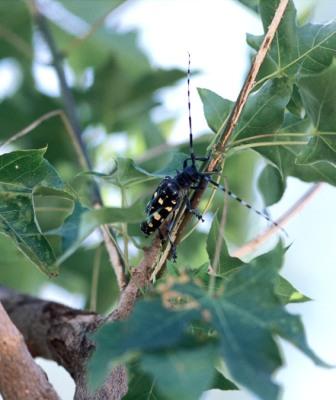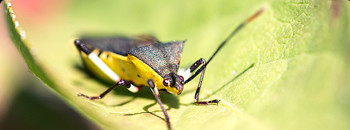
Asian longhorned beetles (ALB) recently have been infesting and killing trees across the country. After being introduced to the U.S. from Asia, experts now consider the beetle to be one of the most destructive invasive insects. The pest is most active in the summer and early fall, and ALB infestation has resulted in the death and removal of more than 30,000 trees. Do you know how to look for signs of an ALB infestation? Do you know the tips on how to save the trees at risk? Keep reading to help stop the beetles from destroying your trees.
The Asian longhorned beetle is harmful to humans, pets and trees. True or False?
False. The ALB is extremely harmful to trees, but not humans or pets! These beetles are about 1 inch in length. They have long antennae banded with black and white, as well as shiny black bodies with white spots and six legs. They can be found on tree branches, walls, outdoor furniture, cars and sidewalks. During the winter months, the beetle chews holes into the tree bark and lays an egg. Once the eggs evolve into larvae, they tunnel deeper, feeding off the trees they infest. When winter is over, the adult beetles chew their way out of the tree, leaving dime-sized holes. The beetle’s lifecycle can harm trees, resulting in fungal growth, structural weakness, disruption of vascular tissues, and ultimately, tree death.
Property owners can prevent infestation and help save trees. True or False?
True. Taking steps to prevent the spread of the ALB is extremely important. Here are the best ways to prevent the ALB from attacking your trees.
- Purchase firewood where you plan on burning it. This means the wood was cut within 50 miles of where you will build your fire. Moving firewood can cause the ALB to be transported to new sites. Even wood that appears clean and healthy can be infested, so it’s best to always leave firewood at home.
- Diversify the trees you plant. If you’re in a regulated or quarantined area for the beetles, it’s best to avoid planting ALB host trees. These include maple, birch, horse chestnut, polar, willow, elm, ash, mimosa, hackberry, sycamore, mountain ash and London plane. You should inspect your trees regularly to look for signs of infestation, which may include dime-sized holes or sawdust-like material, called frass.
- Report any signs of ALB activity and allow officials to perform surveys on your property. Reporting signs helps officials collect many data points and informs them as to which trees should be removed to prevent further infestation. To eliminate infested areas, some jurisdictions opt to cut and chip and some choose to burn the infested trees. Additionally, the use of the insecticide imidacloprid has been shown to decrease ALB populations and also has been used to prevent the spread of ALB. The insecticide is injected into the tree trunk or soil, with supervision by the USDA, and targets the tree’s active growth area where the beetle feeds and lays eggs.
For more information on ALB, contact your local tree service professionals — http://beetlebusters.info/

